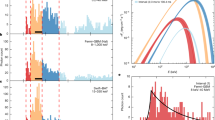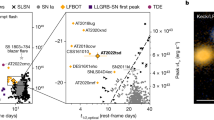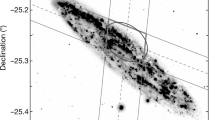Abstract
Highly luminous rapid flares are characteristic of processes around compact objects like white dwarfs, neutron stars and black holes. In the high-energy regime of X-rays and γ-rays, outbursts with variabilities on timescales of seconds or less are routinely observed, for example in γ-ray bursts1 or soft γ-ray repeaters2. At optical wavelengths, flaring activity on such timescales has not been observed, other than from the prompt phase of one exceptional γ-ray burst3. This is mostly due to the fact that outbursts with strong, fast flaring are usually discovered in the high-energy regime; most optical follow-up observations of such transients use instruments with integration times exceeding tens of seconds, which are therefore unable to resolve fast variability. Here we show the observation of extremely bright and rapid optical flaring in the Galactic transient4,5,6,7 SWIFT J195509.6+261406. Our optical light curves are phenomenologically similar to high-energy light curves of soft γ-ray repeaters and anomalous X-ray pulsars8, which are thought to be neutron stars with extremely high magnetic fields (magnetars). This suggests that similar processes are in operation, but with strong emission in the optical, unlike in the case of other known magnetars.
This is a preview of subscription content, access via your institution
Access options
Subscribe to this journal
Receive 51 print issues and online access
$199.00 per year
only $3.90 per issue
Buy this article
- Purchase on Springer Link
- Instant access to full article PDF
Prices may be subject to local taxes which are calculated during checkout



Similar content being viewed by others
References
Mészáros, P. Gamma ray bursts. Rep. Prog. Phys. 69, 2259–2321 (2006)
Kouveliotou, C. in From X-Ray Binaries to Gamma-Ray Bursts (eds van den Heuvel, E. P., Kaper, L., Rol, E. & Wijers, R. A. M. J.) 413–423 (Astronomical Society of the Pacific, 2003)
Racusin, J. L. et al. Broadband observations of the naked-eye γ-ray burst GRB 080319B. Nature 455, 183–188 (2008)
Stefanescu, A. et al. GRB 070610: OPTIMA-Burst high-time-resolution optical observations. GCN Circ. 6492, (2007)
de Ugarte Postigo, A., Castro-Tirado, A. J. & Aceituno, F. GRB 070610: Optical observations from OSN. GCN Circ. 6501, (2007)
Kann, D. A. et al. GRB 070610: TLS RRM sees flaring behaviour - Galactic transient? GCN Circ. 6505, (2007)
Kasliwal, M. M. et al. GRB070610: A curious Galactic transient. Astrophys. J. 678, 1127–1135 (2008)
Kaspi, V. Recent progress on anomalous X-ray pulsars. Astrophys. Space Sci. 308, 1–11 (2007)
Pagani, C. et al. GRB 070610: Swift detection of a burst. GCN Circ. 6489, (2007)
Barthelmy, S. D. et al. The Burst Alert Telescope (BAT) on the SWIFT Midex Mission. Space Sci. Rev. 120, 143–164 (2005)
Gehrels, N. et al. The Swift Gamma-Ray Burst Mission. Astrophys. J. 611, 1005–1020 (2005)
Burrows, D. N. et al. The Swift X-Ray Telescope. Space Sci. Rev. 120, 165–195 (2005)
Weisskopf, M. C. et al. An overview of the performance and scientific results from the Chandra X-Ray Observatory. Publ. Astron. Soc. Pacif. 114, 1–24 (2002)
Stefanescu, A. et al. GRB 070610: OPTIMA-Burst detection of continued strong flaring activity. GCN Circ. 6508, (2007)
Markwardt, C. B. et al. SWIFT J195509.6+261406 / GRB 070610: A potential Galactic transient. Astronom. Telegr. 1102, (2007)
Kanbach, G. et al. in High Time Resolution Astrophysics (eds Phelan, D., Ryan, O. & Shearer, A.) 153–169 (Springer, 2008)
Hurley, K. et al. Reactivation and precise interplanetary network localization of the soft gamma repeater SGR 1900+14. Astrophys. J. 510, L107–L109 (1999)
Castro-Tirado, A. J. et al. Flares from a candidate Galactic magnetar suggest a missing link to dim isolated neutron stars. Nature 10.1038/nature07328 (this issue)
Kaspi, V. et al. A major soft gamma repeater-like outburst and rotation glitch in the no-longer-so-anomalous X-Ray Pulsar 1E 2259+586. Astrophys. J. 588, L93–L96 (2003)
Durant, M. & van Kerkwijk, M. H. Multiwavelength variability of the magnetar 4U 0142+61. Astrophys. J. 652, 576–583 (2006)
Kosugi, G., Ogasawara, R. & Terada, H. A variable infrared counterpart to the soft gamma-ray repeater SGR 1806–20. Astrophys. J. 623, L125–L128 (2005)
Testa, V. et al. Adaptive optics, near-infrared observations of magnetars. Astron. Astrophys. 482, 607–615 (2008)
Beloborodov, A. M. & Thompson, C. Corona of magnetars. Astrophys. J. 657, 967–993 (2007)
Uemura, M. et al. Outburst of a black hole X-ray binary V4641 Sgr in 2004 July. Info. Bull. Var. Stars 5626, 1 (2005)
Uemura, M. et al. Optical observation of the 2003 outburst of a black hole X-Ray binary, V4641 Sagittarii. Publ. Astron. Soc. Jpn 56, 823–829 (2004)
Acknowledgements
We thank the Skinakas Observatory for their support and allocation of telescope time, and acknowledge the allocation of Chandra DDT time. We thank F. Schrey, T. Kougentakis and G. Paterakis for technical support, A. de Ugarte Postigo for access to private data taken simultaneous to some of our observations and A. Castro-Tirado for discussions. Skinakas Observatory is a collaborative project of the University of Crete, the Foundation for Research and Technology - Hellas, and the Max-Planck-Institute for Extraterrestrial Physics. A. Stefanescu acknowledges support from OPTICON. A. Słowikowska acknowledges support of the European Union through a Marie Curie Transfer of Knowledge Fellowship within the Sixth Framework Programme. S.McB. acknowledges the support of the European Union through a Marie Curie Intra-European Fellowship within the Sixth Framework Programme. G.S. is supported through DLR.
Author information
Authors and Affiliations
Corresponding authors
Rights and permissions
About this article
Cite this article
Stefanescu, A., Kanbach, G., Słowikowska, A. et al. Very fast optical flaring from a possible new Galactic magnetar. Nature 455, 503–505 (2008). https://doi.org/10.1038/nature07308
Received:
Accepted:
Issue Date:
DOI: https://doi.org/10.1038/nature07308
This article is cited by
-
Minutes-duration optical flares with supernova luminosities
Nature (2023)
-
A model for the optical flares from the Galactic transient SWIFT J195509+261406
Science China Physics, Mechanics and Astronomy (2010)
-
Afterglow from GRB 070610/Swift J195509.6+261406: An explanation using the fireball model
Science China Physics, Mechanics and Astronomy (2010)
-
How fast can you blink?
Nature (2008)
-
Magnetar flashes astronomers
Nature (2008)
Comments
By submitting a comment you agree to abide by our Terms and Community Guidelines. If you find something abusive or that does not comply with our terms or guidelines please flag it as inappropriate.



